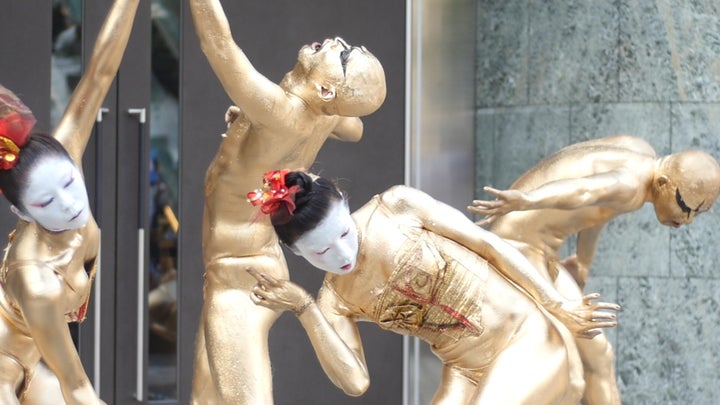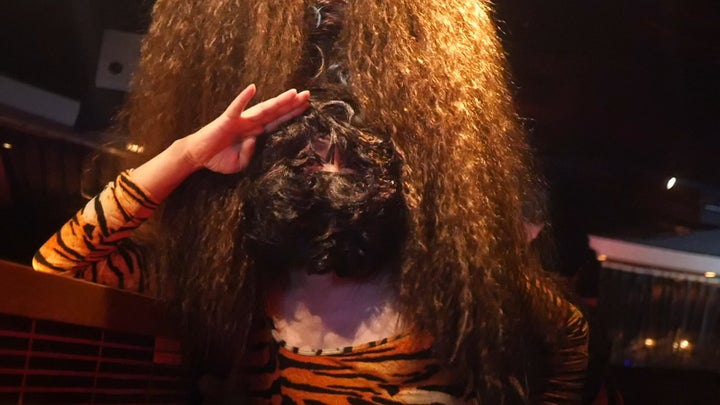"Queer Japan," a powerful new documentary currently in production, examines queer art, culture and activism in the Asian island nation.
Because many of the images and ideas about queer culture that Americans are typically most familiar with tend to originate from a Western perspective, Graham Kolbeins and Anne Ishii want their film to provide an authentic representation of what it means to be queer in Japan.
The pair, who have been working together for years editing anthologies of gay and feminist manga, are focusing this new project on individuals like drag queen, artist, and film critic Vivienne Sato, gay manga master and art historian Gengoroh Tagame, and feminist manko (pussy) artist Rokudenashiko and her fight against obscenity charges for her work -- just to name a few.
The Huffington Post talked with Kolbeins this week about "Queer Japan" and the project's Kickstarter, as well as what he and Ishii are trying to accomplish with the film.

The Huffington Post: Why did you decide to do this project?
Graham Kolbeins: There's an incredibly rich queer culture in Japan with fascinating histories behind it, but people outside of Japan (and within) rarely hear about it. My interest in the subject began when I was came across images of work by gay manga artists like Gengoroh Tagame and Jiraiya as a teenager. Their artwork opened worlds of possibility for me, providing depictions of homosexuality that I could relate to more than anything I'd seen in Western gay media at the time. Since 2012, Anne Ishii and I have had the privilege of working with those same artists to help spread their work in North America and around the world, through art shows, fashion collections, and manga anthologies (The Passion of Gengoroh Tagame and Massive: Gay Erotic Manga and the Men Who Make It).
The work Anne and I have been doing at MASSIVE GOODS has led us to explore gender and sexuality in Japan in a broader sense. Recently we've expanded beyond the gay manga genre to work with artists like Rokudenashiko, who is currently on trial for obscenity charges related to her 3D-printed vagina art. The more I learned about these quietly revolutionary queer individuals in Japan, the more I wanted to share these stories with the world, and that lead to the idea of doing a documentary on the subject.

Tell me more about the people you are highlighting in the film.
So far we've shot interviews with drag queen, film critic, "non-architect" and all-around renaissance woman Vivienne Sato; gay manga master and historian Gengoroh Tagame, along with his G-men magazine co-founder, community leader, and HIV activist Hiroshi Hasegawa; visual artist Nogi Sumiko; Atsushi Matsuda, a dancer in the Butoh group DAIRAKUDAKAN; controversial manko [pussy] artist Rokudenashiko; and countryside bar owner/queer theorist Masaki C. Matsumoto. We'd like to follow these peoples' stories and continue expanding the film's scope over a five month shoot to include as many queer people in Japan as possible.

What is unique about queer culture in Japan? How is it different from the rest of the world?
Global and local influences are deeply intertwined in Japan's queer culture. If you look back to the Edo Period, an entire genre of literature and art based on male-male courtship flourished, called shudo ("The way of youth"). Hundreds of books, including the poet Saikaku's bestselling 1687 short story collection, "The Great Mirror of Male Love," were published and if you were a wealthy male, a member of the clergy, or a beautiful adolescent boy (bishonen), your homosexual relations were generally accepted by society. That all changed after Japan's doors were forcibly opened to Western trade by America in the mid-19th century. The era of rapid modernization that followed did away with "uncivilized" things of the Japanese past including shudo, and soon medico-scientific models that pathologized queer sexualities were imported from Germany and elsewhere.
During the U.S. Occupation of Japan following the second World War, censorship and restrictions on the press were lifted and a new gay culture emerged. Dozens of gay bars opened up in the cities and the gei boi (gay boys) who worked there, often in drag, were widely reported on in the Japanese press, decades before the word "gay" was used widely in American discourse. Media representation and physical spaces for gay, lesbian, and transgender people continued to evolve over the 20th century, largely independent from Western influence. In the 1980s and 1990s, the gay rights movement went global in the wake of the AIDS crisis, and the Western terms like "LGBT" began to be used by homegrown Japanese gay rights groups like OCCUR, which was influenced by Act Up.

Today, queer culture is both incredibly robust and hidden just beneath the surface of Japanese public life. It's rare to see public displays of affection (queer or otherwise) on the streets of Tokyo, so queer expressions aren't exactly visible -- but at the same time, gay entertainment district Shinjuku Ni-chome is home to over 120 small bars servicing all facets of the queer community. I can't think of anywhere else in the world that has so many establishments for LGBTQ+ people, and that's just one neighborhood in Tokyo! In the Japanese mainstream media, queer issues are often ignored and representations are usually limited to comic relief. But within these microcosms of queer community, the culture is flourishing.
What do you want people to take away from this film?
Mainly, I would like to introduce viewers around the world to a variety of queer people in Japan who I think are doing really inspiring things. It's important to me that this film is giving a voice to its subjects and tells their stories in a way that viewers can empathize with. I want to avoid getting too historical or theoretical in the film and focus on the reality of people's lives. In the past few years there has been a deluge of English-language articles and documentaries sensationalizing "sex in Japan" and approaching the subject from an exoticizing perspective that I find problematic. As a white foreigner, I think it's important for me to take a step back from judging Japanese sexual cultures and forcing them into a false dichotomy with the West. Instead, let's celebrate them! There is no singular "queer Japan," but in this film we hope to show a handful of the many dazzling forms gender and sexuality can take.
Head here to visit the "Queer Japan" Kickstarter.
